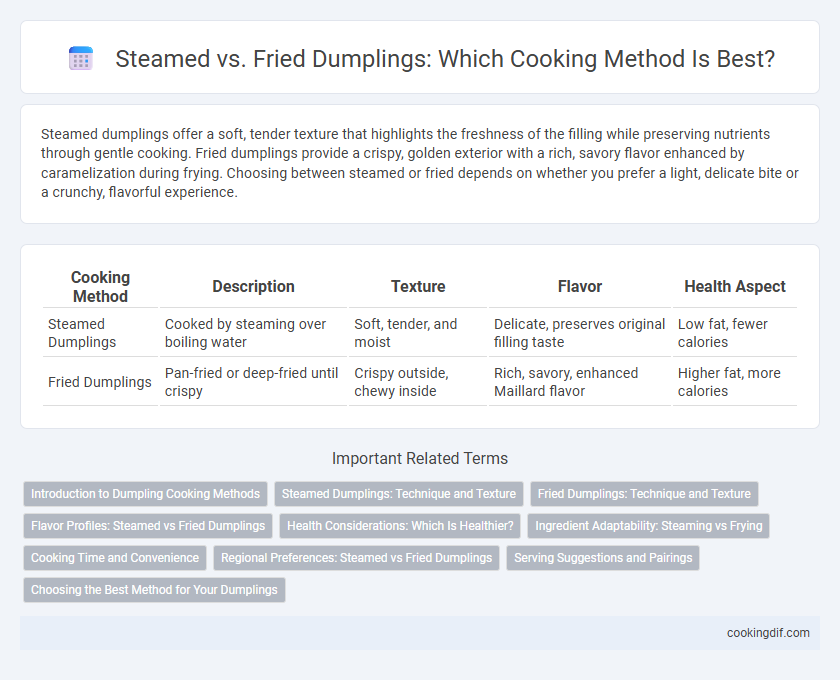Steamed dumplings offer a soft, tender texture that highlights the freshness of the filling while preserving nutrients through gentle cooking. Fried dumplings provide a crispy, golden exterior with a rich, savory flavor enhanced by caramelization during frying. Choosing between steamed or fried depends on whether you prefer a light, delicate bite or a crunchy, flavorful experience.
Table of Comparison
| Cooking Method | Description | Texture | Flavor | Health Aspect |
|---|---|---|---|---|
| Steamed Dumplings | Cooked by steaming over boiling water | Soft, tender, and moist | Delicate, preserves original filling taste | Low fat, fewer calories |
| Fried Dumplings | Pan-fried or deep-fried until crispy | Crispy outside, chewy inside | Rich, savory, enhanced Maillard flavor | Higher fat, more calories |
Introduction to Dumpling Cooking Methods
Steamed dumplings retain a delicate, soft texture and highlight the natural flavors of the filling, making them a healthier option due to minimal oil use. Fried dumplings develop a crispy golden crust that contrasts with the tender interior, offering a rich, savory experience preferred in many Asian cuisines. Understanding the differences between steaming and frying helps optimize cooking techniques to suit taste preferences and nutritional goals.
Steamed Dumplings: Technique and Texture
Steamed dumplings are cooked by placing them in a bamboo steamer over boiling water, allowing gentle, moist heat to cook the dough and filling evenly. This method preserves the dumplings' delicate texture, resulting in a soft, tender wrapper that complements the juicy, flavorful interior. The steaming process also retains the dumplings' natural moisture, offering a light and healthy alternative to frying.
Fried Dumplings: Technique and Texture
Fried dumplings offer a crispy and golden exterior achieved by pan-frying in oil until the bottom is crunchy while the top remains tender from steaming. The technique involves cooking dumplings in hot oil, then adding water and covering to steam, resulting in a perfect combination of textures. This method enhances the dumpling's flavor profile with a rich, savory crunch contrasted against the soft, juicy filling inside.
Flavor Profiles: Steamed vs Fried Dumplings
Steamed dumplings offer a delicate, moist texture with a subtle, clean flavor that highlights the freshness of the filling ingredients. Fried dumplings provide a crispy, golden-brown exterior that enhances the savory, umami-rich taste, adding a satisfying crunch to each bite. Choosing between steamed and fried methods depends on whether a tender, juicy experience or a bold, textured flavor profile is desired.
Health Considerations: Which Is Healthier?
Steamed dumplings retain more nutrients and contain fewer calories and less oil compared to fried dumplings, making them a healthier option. Fried dumplings have a higher fat content due to the oil absorbed during cooking, increasing calorie intake and potential cholesterol concerns. Choosing steamed dumplings supports better digestion and weight management while maintaining flavor and texture.
Ingredient Adaptability: Steaming vs Frying
Steaming dumplings preserves the delicate texture and moisture of ingredients like minced pork, shrimp, and vegetables, ensuring a tender bite without added fat. Frying dumplings imparts a crispy, golden crust that enhances firmer fillings such as pork belly or beef, offering a contrasting crunch while intensifying flavors through caramelization. Ingredient adaptability between steaming and frying allows versatile culinary experiences, as softer fillings thrive with steaming, while heartier, moisture-rich fillings benefit from frying's texture transformation.
Cooking Time and Convenience
Steamed dumplings generally take 10-15 minutes to cook, preserving their delicate texture and moisture, making them a healthier option with minimal oil use. Fried dumplings cook faster, typically within 5-7 minutes, offering a crispy exterior and rich flavor but requiring more attention and oil management for even browning. Convenience-wise, steaming demands a steamer setup and slightly longer cooking time, while frying offers quick results with easier monitoring but involves more cleanup due to oil splatter.
Regional Preferences: Steamed vs Fried Dumplings
Steamed dumplings are traditionally favored in Northern China, prized for their delicate, tender wrappers and juicy fillings, while fried dumplings dominate Southern Chinese cuisine with their crispy, golden exteriors and rich texture contrast. In Japan, gyoza--often pan-fried to achieve a crunchy bottom with a soft upper wrapper--reflects a regional hybrid approach blending steaming and frying techniques. Southeast Asian countries like Vietnam and Thailand prefer steaming dumplings to preserve subtle flavors and maintain a light, moist texture suited to their culinary palate.
Serving Suggestions and Pairings
Steamed dumplings, with their light and delicate texture, pair perfectly with soy-based dipping sauces infused with ginger and scallions, making them ideal for serving alongside fresh vegetable salads or mild broths. Fried dumplings offer a crispy, golden exterior that complements spicy chili oil or vinegar-based dips, enhancing dishes like pickled vegetables or rich, savory soups. Both cooking methods benefit from garnishes such as fresh cilantro or toasted sesame seeds to elevate the overall flavor profile.
Choosing the Best Method for Your Dumplings
Steamed dumplings retain moisture and highlight delicate flavors, making them ideal for lighter fillings like vegetables or seafood. Fried dumplings offer a crispy texture and richer taste, perfect for meat or hearty fillings that benefit from added crunch. Choosing the best cooking method depends on the desired texture and flavor profile, balancing health considerations with taste preferences.
Steamed vs Fried for dumpling cooking methods Infographic

 cookingdif.com
cookingdif.com